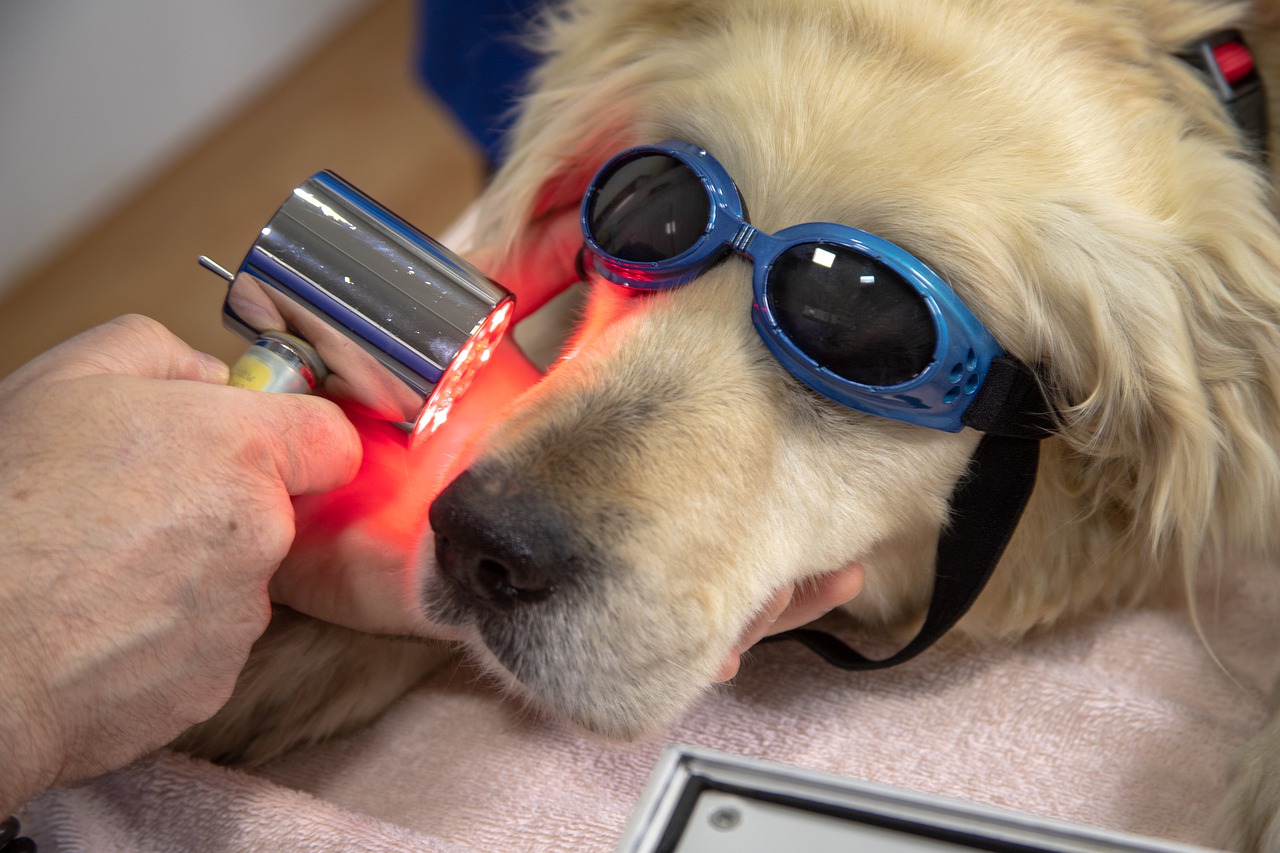It’s hard to see our pets suffer; no owner wants to see their dog in pain. Dogs may not be able to show their suffering instinctively just like we humans do, and that’s why we may not realize they are in pain at first. It all depends on us as their guardians to recognize the subtle signals and offer them help.
There are various methods to treat pain in dogs such as medications, acupuncture, anti-inflammatory drugs, and laser therapy. Laser Therapy for dogs is one of the advanced yet effective methods.
Let’s learn how laser therapy can cure pain in dogs but first, let’s understand the types of pain.
Table of Contents
What is pain?
Pain is an unpleasant and annoying feeling that may be the sign of something wrong with one of your dog’s organs and it can limit your dog’s capabilities and abilities to act normal and do its routine tasks. Pain is usually considered an early warning signal that something is wrong with your dog’s body. It can vary from mild to acute and has different stages. It can also be short-term or chronic and long-term.
Acute pain may occur suddenly in the blink of an eye and is a warning sign that the body has suffered an injury. It usually goes away when the wound has healed. A common example of acute pain is when the dog hits a hard object – it will hurt for a short time, but then it will go away on its own if it’s not severe. In severe cases, treatment by the vet is necessary.
Chronic pain lasts longer than acute pain and is sometimes resistant to treatments. It is usually associated with a chronic disease. Unlike acute pain, chronic pain tends to be related to a dysfunction of the body or persistent disease.
Related: Ways to treat senior dog’s Arthritis Joint Pain
How can I tell if my dog is in pain?
Dogs with pain are less likely to consume their routine food and act abnormally. The other common symptoms are:
- They will be depressed.
- Lethargic (tired) and may refuse to move or walk.
- Aggressive.
- Will refuse to be touched on certain parts of the body (i.e. the painful parts).
Some dogs may also whine and lick their painful areas excessively, limp, etc., depending on the location and nature of the pain.
How to treat pain in dogs?
There are various methods to treat pain in dogs depending on the condition and severity of the pain but it’s good to consult with a vet first. If you are in a remote area where it is difficult to visit a vet in an emergency, you can also use laser therapy for pain management in your dog.
What’s Laser Therapy? Let’s find out below.
Laser therapy for Dogs – What & How
Laser therapy is done with the help of a device that produces light of different wavelengths, with positive effects on damaged tissues. It uses warm or cold light. The devices that can be used at home by pet owners use cold light, so you and your dog won’t need goggles.
The laser device produces a photochemical reaction in the body’s cells which has a therapeutic effect. Laser therapy stimulates the cells to multiply faster and accelerates the repair and healing process of the damaged tissues. The light absorbed by these tissues is transformed into useful energy.
Laser therapy has no negative effects on healthy tissues, and you can use the device from the comfort of your home.
Laser therapy can be used to treat various issues in dogs, such as:
- It stimulates blood flow, reducing inflammation and pain.
- It increases collagen production, helping to heal tendons and ligaments.
- Relaxes muscles.
- Stimulates nerve regeneration.
- It helps with lymphatic flow and drainage.
- It promotes protein synthesis.
- It promotes ATP (Adenosine triphosphate) production.
The diseases that manifest with pain in dogs are:
- Oral problems – gingivitis, periodontitis, tooth loss, etc.
- Arthritis
- Otitis
- Intervertebral Disc Disease (IVDD)
- Tendonitis
- Muscle injuries
- Knee problems
- Neck problems
- Wounds and burns
- Pododermatitis
- Anal sac rupture
- Back and spinal problems
- Nerve problems
If your dog suffers from one of these conditions, laser therapy can help improve its pain and promote healing. You can use the laser device at home by holding it for 4 minutes on each side of the affected area. The degree of improvement will depend on the individual and the medical condition. Some dogs will recover faster than others. Other pets will need laser therapy treatments over a long period but expect to see some improvements after the first few uses.
Usually, the experts suggest using the laser therapy device twice a day at home for the best results and making sure to choose the best cold laser therapy device for dogs.
You can also use laser therapy in combination with medical or surgical treatment to accelerate regeneration and healing.
You may like reading about Dog Abortion Facts
Other recommended methods to treat pain in dogs
The most popular method of treating pain in dogs is giving it medication. Depending on the type and cause of the pain, you can administer the following drugs can:
- Analgesic drugs (chronic pain)
- Steroids
- Anti-inflammatory drugs (especially for joint pain)
Note: Your first preference should be a thorough examination of your dog by the vet.
There are several FDA-approved pain medications that you can give your dog. These medications are specifically designed for a dog’s body and metabolism.
Among the most recognized brands used and recommended by many veterinarians are Rimadyl and Previcox. There are also several approved generic names of drugs to choose from. These drugs are administered orally or by injection and have proven effectiveness in controlling pain and reducing inflammation in bones, muscles, and tissues.
These medications are usually safe for dogs and have fewer side effects. However, there have been cases of liver, stomach, or kidney occurring from using some of these drugs.
If your dog suffers from more intense and specific pain, you can give it stronger drugs, such as Gabapentin. Gabapentin is used in the treatment of peripheral neuropathic pain in dogs and humans. Among the adverse effects is excessive sleepiness, but this effect will pass after the first administration.
Another strong drug is Amantadine, a medicine used to treat Parkinson’s disease in humans. It can be prescribed for dogs suffering from disc disease, arthritis, and cancer. Side effects in dogs associated with Amantadine generally include restlessness and diarrhea.
Tramadol is a mild opioid that your veterinarian may prescribe for older dogs that are continually struggling with discomfort. Side effects of this medicine usually include dizziness, vomiting, and stomach pain.
Some other methods to treat pain in dogs are:
- Administration of supplements (nutraceuticals)
- Cold or warm compresses
- Acupuncture
Although these methods are not as effective as administering drugs, if your dog is suffering from mild pain, you can try them. But veterinary acupuncture may be an option for your dog to relieve its arthritis naturally, without the use of medication. Acupuncture works by stimulating the nerves and increasing blood circulation. It relieves muscle spasms and causes the release of hormones such as endorphins (one of the chemicals for controlling pain in the body) and cortisol (a natural steroid). In addition, the process is almost painless for dogs. A dog receiving acupuncture treatments for arthritis pain relief will begin to benefit after several sessions.
Wrapping it up:
So, it was everything you needed to know about the use of laser therapy to treat pain in dogs. Whatever method you choose, make sure to consult with your veterinarian first because a detailed checkup and diagnosis are important. Without the diagnosis, you may end up doing something wrong with your dog.
Recommended read – Golden Dox Dog Breed Guide for 2022










